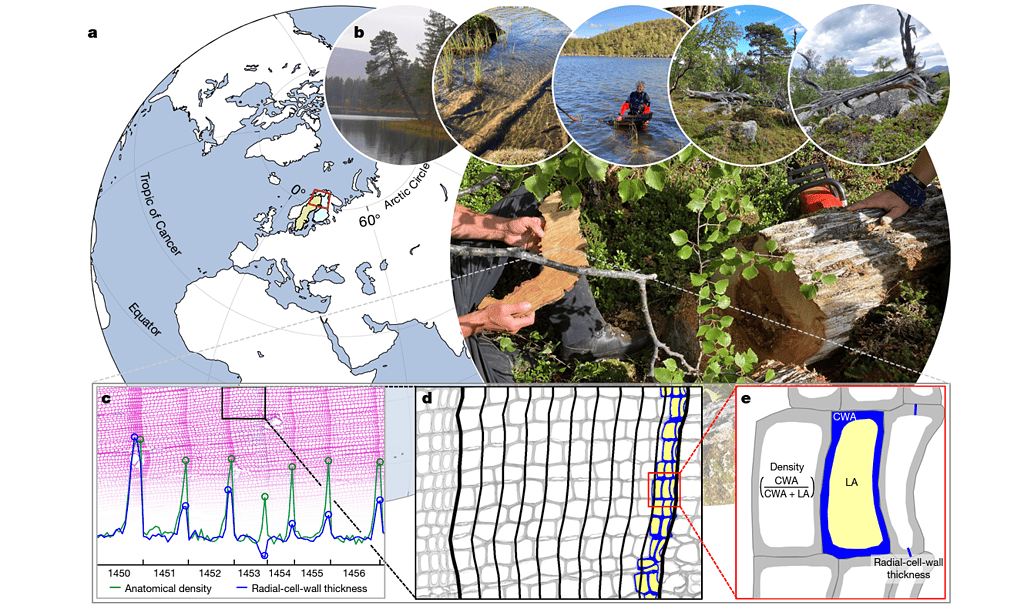
Some trees are thousands of years old, and they’re still alive. Imagine if they could talk, what stories they could tell. Well, as a matter of fact they do, in a way! Scientists often turn to tree rings to infer minute details about what the climate was like even centuries in the past in the area where the tree grew.
Case in point, researchers used a novel method of analysis of tree-ring records from Fennoscandia, a region in northern Europe, revealing new insights that could be key to understanding the impact of human activities on the planet’s climate.
The study, recently published in Nature, shows that the current climate is much hotter than during the Medieval Warm Period, an era when the world experienced an unusual temperature rise, contrary to previous studies.
Climate clues in wood cells
The Medieval Warm Period (MWP), also known as the Medieval Climate Anomaly, was a period of relatively warmer temperatures that occurred from approximately 900 to 1300 CE. During this time, the Earth experienced a significant warming trend, influencing various aspects of human civilization.
The warmer temperatures during the MWP had diverse effects on societies across the globe. In some regions, agricultural productivity flourished, leading to increased crop yields and population growth. Norse settlements in Greenland and Iceland expanded as farming became more viable. Trade routes shifted, and civilizations adapted to the changing climate.
Understanding past climate episodes, such as the MWP, has been a subject of much debate among scientists. Tree rings have proven to be valuable records of climate changes over extended periods, allowing researchers to track climate extremes. Yet, when scientists compare tree-ring data to their climate models for the medieval climate, they found discrepancies that are hard to explain. While models have suggested cooler temperatures during this period compared to the present, tree-ring data often tell a different story.
The seeds for the new study were sown a few years ago when Jesper Björklund, a researcher at the Swiss Federal Institute for Forest Snow and Landscape Research, and colleagues discovered that the accuracy of tree-ring data as a natural archive of climate variations improves with the level of detail in wood cell measurements.
Unprecedented precision in tree ring data
Armed with this knowledge, they set out to explore the implications this precision could have on existing long-term climate records. The study focused on Fennoscandia, a region known for its ancient trees. Previously, tree ring data from Fennoscandia confusingly portrayed the Medieval Warm Period as equally warm or even warmer than today. This puzzled scientists, as climate model simulations did not account for such extended warmth during that era without additional factors like elevated greenhouse gas concentrations or increased solar radiation.
By employing state-of-the-art methods and analyzing a staggering 50 million individual wood cells from 188 Scots pine trees, the researchers gained an unprecedented level of accuracy in their climate data. What they found was exciting—the Medieval climate was not as warm as previously believed. Instead, it aligned closely with climate models’ temperature history simulations over the past millennium.
“The new data from the highly precise methodology we used revealed that the Medieval climate was not as warm as previously thought and aligns rather well with how climate models simulate the temperature history of the past millennium. This is very important because it indicates that the natural variability in the region is smaller than previously thought and anthropogenically induced climate variability is more dominant than previously thought. It, therefore, lends new credibility to future model simulations, and that greenhouse gases will be very important in driving climate change in this region,” Björklund told ZME Science.
What sets this study apart from previous techniques is the depth at which the researchers delved into the wood to extract climate information. While previous methods used X-ray technology to estimate wood density and relate it to climate variations, this study went a step further.
By zooming in on the cell walls of each individual cell, they measured their dimensions. These measurements provided a rich climate record, as the shape and size of each cell were influenced by the weather and climate conditions at the time of its formation. The result was an exceptionally pure representation of climate variations in the Fennoscandian region.
Of course, nothing about this was trivial. The main obstacle in this study was the time required to analyze the trees. The researchers employed semi-automated image analysis techniques to study the individual cells and cell walls in the wood. This painstaking process took months if not years. However, there’s hope on the horizon! The team has begun experimenting with AI-assisted image analysis, which promises to accelerate the creation of such climate records significantly.
“If we would have had these capabilities when we started this study, we could have saved months, perhaps even years, of work… so a little bit bittersweet,” says Björklund.
But how do these findings tie into the current climate crisis? They provide crucial support for model simulations of future climates and underscore the role of human influence on climate change. While the study’s relevance is specific to Northern Europe, it paves the way for further research using this technique to revise climate history elsewhere. Importantly, it demonstrates that anthropogenic climate change is indeed palpable at local scales, an aspect that has presented a challenge for scientists until now.



